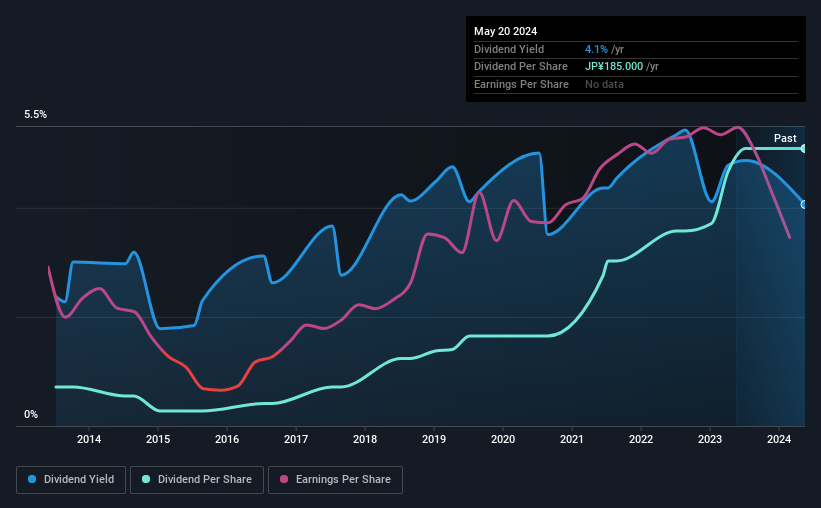Share

The board of Tama Home Co., Ltd. (TSE:1419) has announced that it will be paying its dividend of ¥185.00 on the 30th of August, an increased payment from last year's comparable dividend. This takes the dividend yield to 4.1%, which shareholders will be pleased with.
View our latest analysis for Tama Home
Tama Home Doesn't Earn Enough To Cover Its Payments
If the payments aren't sustainable, a high yield for a few years won't matter that much. Based on the last payment, earnings were actually smaller than the dividend, and the company was actually spending more cash than it was making. Paying out such a large dividend compared to earnings while also not generating any free cash flow would definitely be difficult to keep up.
Over the next year, EPS could expand by 0.06% if the company continues along the path it has been on recently. If the dividend continues on its recent course, the payout ratio in 12 months could be 152%, which is a bit high and could start applying pressure to the balance sheet.

Dividend Volatility
The company's dividend history has been marked by instability, with at least one cut in the last 10 years. The annual payment during the last 10 years was ¥26.00 in 2014, and the most recent fiscal year payment was ¥185.00. This implies that the company grew its distributions at a yearly rate of about 22% over that duration. It is great to see strong growth in the dividend payments, but cuts are concerning as it may indicate the payout policy is too ambitious.
Tama Home May Find It Hard To Grow The Dividend
With a relatively unstable dividend, it's even more important to evaluate if earnings per share is growing, which could point to a growing dividend in the future. Tama Home hasn't seen much change in its earnings per share over the last five years. The earnings growth is anaemic, and the company is paying out 119% of its profit. Limited recent earnings growth and a high payout ratio makes it hard for us to envision strong future dividend growth, unless the company should have substantial pricing power or some form of competitive advantage.
Tama Home's Dividend Doesn't Look Sustainable
In summary, while it's always good to see the dividend being raised, we don't think Tama Home's payments are rock solid. The track record isn't great, and the payments are a bit high to be considered sustainable. Overall, we don't think this company has the makings of a good income stock.
Market movements attest to how highly valued a consistent dividend policy is compared to one which is more unpredictable. Meanwhile, despite the importance of dividend payments, they are not the only factors our readers should know when assessing a company. For example, we've identified 2 warning signs for Tama Home (1 is potentially serious!) that you should be aware of before investing. If you are a dividend investor, you might also want to look at our curated list of high yield dividend stocks.
If you're looking to trade Tama Home, open an account with the lowest-cost platform trusted by professionals, Interactive Brokers.
With clients in over 200 countries and territories, and access to 160 markets, IBKR lets you trade stocks, options, futures, forex, bonds and funds from a single integrated account.
Enjoy no hidden fees, no account minimums, and FX conversion rates as low as 0.03%, far better than what most brokers offer.
Sponsored ContentValuation is complex, but we're here to simplify it.
Discover if Tama Home might be undervalued or overvalued with our detailed analysis, featuring fair value estimates, potential risks, dividends, insider trades, and its financial condition.
Access Free AnalysisHave feedback on this article? Concerned about the content? Get in touch with us directly. Alternatively, email editorial-team (at) simplywallst.com.
This article by Simply Wall St is general in nature. We provide commentary based on historical data and analyst forecasts only using an unbiased methodology and our articles are not intended to be financial advice. It does not constitute a recommendation to buy or sell any stock, and does not take account of your objectives, or your financial situation. We aim to bring you long-term focused analysis driven by fundamental data. Note that our analysis may not factor in the latest price-sensitive company announcements or qualitative material. Simply Wall St has no position in any stocks mentioned.
About TSE:1419
Tama Home
Engages in the construction, architectural design, real estate, and insurance agency businesses in Japan.
Flawless balance sheet average dividend payer.
Market Insights
Community Narratives


